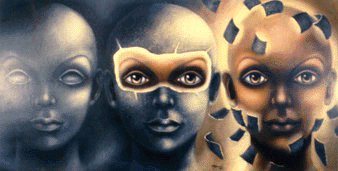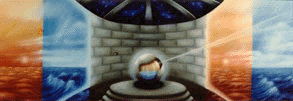
 Uncovering the Self, By Mariu Suarez, 48"x24", Oil and egg-tempera on canvas |
"The creative process, so far as we are able to follow it at all, consists in the unconscious activation of an archetypal image and elaborating and shaping the image into the finished work. By giving it shape, the artist translates it into the language of the present and so makes it possible for us to find our way back to the deepest springs of life."
- Carl Jung |
|
Available for Sale (PDF) |
Art has always been an integral part of humanity's great quest for knowledge. The interchange of knowledge between artists and scientists has led to many of our most important advances. For example:
- It was artists' zeal to perfect their craft that led to a better understanding of human anatomy. Masters of the human form, such as Michelangelo, broke social taboos and laws in order to study the human body through the dissection of corpses. Their anatomical research later became a vital part of medical knowledge.
- Geographers and map makers created mathematical grids to make accurate maps. Artists used that innovation to translate three dimensions into two dimensions.
- It was painters who discovered the principles of optics while examining how the eye sees in order to better "trick" the eye with their images.
In this way, Freud unwittingly rekindled an interest in the metaphysical realm, which science had shunned in its quest for knowledge. He then endeavored to study it in the same way the physical level had been: By applying reason. One of Freud's most prominent disciples, Dr. Carl Jung, further developed the field of psychology and the understanding of the psyche. Just like William Shakespeare's influence on literature, Freud's impact on psychology is immeasurable.
Freud and Jung began a whole new era for mankind by mapping the threefold constitution of man: the Spiritual, the psychic, and the material. They brought to the forefront the contents of the psyche as represented in ancient mythology and symbolism and taught us that the psyche can be understood through reason.
While Freud laid the scientific groundwork, Jung leaped forward in his exploration of how the unconscious reveals itself though symbols. In this respect, artists once again were needed to join the quest for knowledge. Jung himself painted and sculpted his dreams and visions so that he could better understand them.
Dissecting the Psyche
Jung's theory of the human psyche is that it is made up of three parts: the ego (conscious mind), the personal unconscious, and the collective unconscious. As C. George Boeree, Ph.D., explains it, the collective unconscious is "the reservoir of our experiences as a species, a kind of knowledge we are all born with. And yet we can never be directly conscious of it.
 It influences all of our experiences and behaviors, most especially the emotional ones, but we only know about it indirectly, by looking at those influences. The contents of the collective unconscious are called archetypes.
It influences all of our experiences and behaviors, most especially the emotional ones, but we only know about it indirectly, by looking at those influences. The contents of the collective unconscious are called archetypes.
"An archetype is an unlearned tendency to experience things in a certain way. The archetype has no form of its own, but it acts as an 'organizing principle' on the things we see or do. The archetype is like a black hole in space: You only know it's there by how it draws matter and light to itself."
Self Discovery Through Art
For the purpose of personal analysis, Jung had talked about not judging the images of the subconscious, but simply accepting them as they came into consciousness so they could be analyzed. This was termed Automatism.
Artists were fascinated by the implications of these new psychological theories. They understood from them that the unconscious has important messages for the conscious mind, but the former communicates through images (symbols and archetypes) while the latter communicates through language.
 Supraconsciousness, By Mariu Suarez, 62"x22", Oil and egg-tempera on canvas |
Surrealist artists wanted their work to be a link between the abstract spiritual realities and the real forms of the material world. To them, the object stood as a metaphor for an inner reality. Through their craft, whether it be painting, sculpting or drawing, artists could bring the inner realities of the subconscious to the conscious mind, so that their meaning could be deciphered through analysis. Just as Michelangelo and Leonardo advanced the knowledge of the body's anatomy, surralist artists strive to chart the anatomy of the psyche.
Every individual can, as Jung did, use art to bring forward messages from his or her own personal unconscious. But the vital role of the artist is to help us all see the messages that emanate from the collective unconscious. As Carl Jung put it:
-
"Therein lies the social significance of art: It is constantly at work educating the spirit of the age, conjuring up the forms in which the age is more lacking. The unsatisfied yearning of the artist reaches back to the primordial image in the unconscious, which is best fitted to compensate the inadequacy and one-sidedness of the present. The artist seizes on this image and, in raising it from deepest unconsciousness, he brings it into relation with conscious values, thereby transforming it until it can be accepted by the minds of his contemporaries according to their powers."
This page is maintained by Monica Sanchez. Your comments are welcomed.

